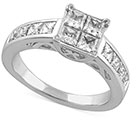Ring Anatomy & Ring Types
Ready to buy the perfect ring? Get to know the parts of a ring and the different types of settings before you shop.
Ring Anatomy
- The head, or setting, is the top of the ring holding the diamond or gemstone.
- The band is typically made with a type of precious metal like gold or platinum.
- The shank is the outer part of the band, which can have channel-set diamonds, pavé diamonds or be polished.
- The prongs, or claws, keep the stone in place.
- The shoulder is the part that joins the band to the head.


Prong Settings
Prong settings feature 4–6 claws or talons that hold the center stone in place. The minimalist setting allows the most light to pass through the stone for maximum brilliance.

Bezel Settings
A bezel setting completely encases the lower part of the stone, perfect for protecting precious gems against scratches and chips.

Invisible Settings
Invisible settings create the appearance of a solid surface of gems through a framework of grooves that allow stones to sit side by side.

Channel Settings
A channel setting is a band that holds a row of what seems to be floating stones since you can't see the metal inside.

Pavé settings
Pavé settings hold small stones closely together to create a paved pattern. This is generally used to surround a larger stone for extra sparkle.